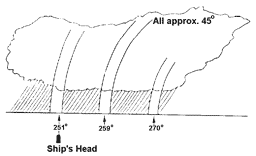 |
Science Frontiers ONLINE No. 78: Nov-Dec 1991 |
|
|
Lunar Rainbow And Unexplained White Arc
April 12, 1990. North Atlantic. Aboard the m.v. Canterbury Star.
 From left to right: normal secondary lunar rainbow (white). Normal primary bow (colored), anomalous secondary bow (white). |
"At 0004 UTC a bright, white arc was seen on the starboard bow and was quickly identified as a lunar rainbow. The moon was one day after its full phase and was just rising; it had little colouration but was unusually bright. A faint, secondary bow became visible outside the main bow at 0010 while the latter, at the same time, began to show colouring; it was possible to see a bluish reddish-orrange colour on the outside, merging into yellow, then to a bluish colour on the inside edge. See sketch. Unfortunately, measurement of the width of these bands was not possible as they were not clear enough. During this time, the outer secondary bow together with a third, inner bow remained faint and were white in colour; the inner secondary bow being nearly too faint to see."
Comments from an expert in meteorological optics remarked that the radii of the primary and outer secondary bows were less than the theoretical values. He dismissed the inner secondary bow as a misinterpretation, since "theory predicts no such inner secondary bow."
(Jackson, C.; "Rainbow," Marine Observer, 61:74, 1991.)
Reference. Our catalog Rare Halos, Mirages covers the above anomaly plus many other unusual optical phenomena. To order, visit: here.